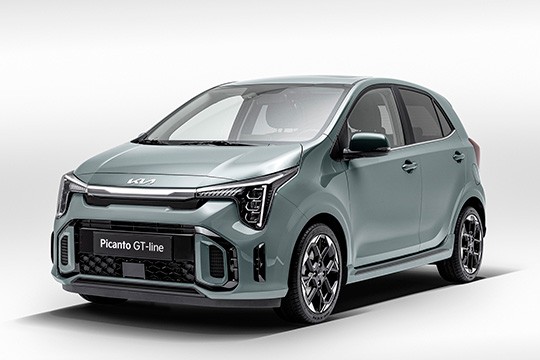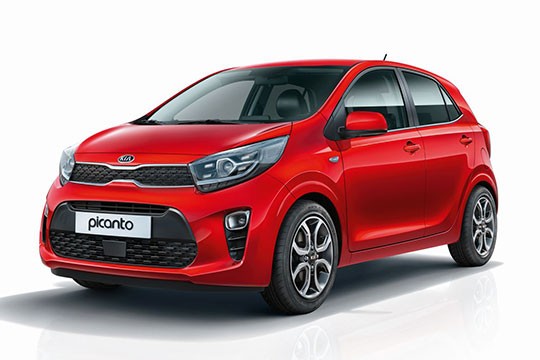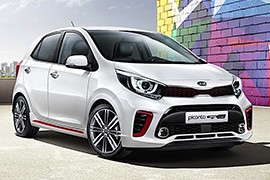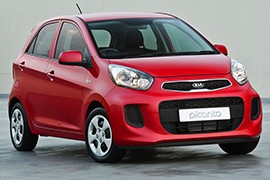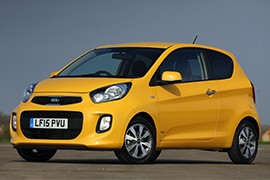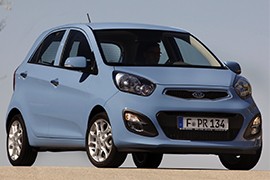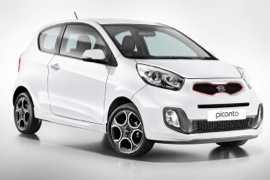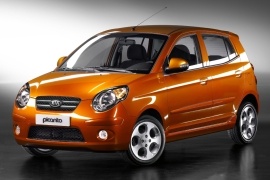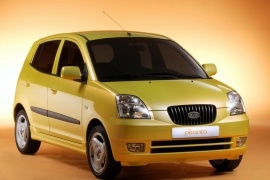KIA Picanto Models/Series Timeline, Specifications & Photos
First production year: 2004
Engines: , Gasoline, Diesel
Body style: Hatchback
The Korean automaker introduced a second refresh for the third generation of the Picanto at the beginning of 2023. Thus, the seven-year-old model became more attractive to customers who didn't want to spend too much on transportation.
Kia used to be that automaker that produced cheap but reliable vehicles. Over the years, the Korean company invested more in technology and became a major player on the world stage. Moreover, it climbed high in the reliability tops with its cars. But, besides its most-known products, such as the Ceed, the Sportage, or the Optima, it also produced the tiny Picanto. Previously, it was a vehicle that impressed only a few people with its design. But all that was changed in 2023, along with the second facelift of the car, which occurred three years after the first refresh and six after the model's introduction.
The front fascia started to resemble other Kia products with its continuous LED light strip that crossed the vehicle from side to side, visually connecting the headlights. Moreover, the GT-Line version featured an air dam adorned with a shiny black rim underlining the lower cooling area. Moreover, the lower grille also hosted the radar for advanced safety systems such as the AEBS or the adaptive cruise control. Usually, that kind of design was mostly seen in sports cars, and the Picanto was far from being one. In addition, the automaker installed additional scoops on the sides that mimicked air intakes to cool the brakes, but those were not functional. The headlights featured three stacked LED lamps and were flanked on their outer sides by vertical daytime running lights. The car's shape didn't change, but at the rear, the automaker installed new taillights and, at the lower part of the bumper, a plastic diffuser.
Inside, the Picanto boasted a digital instrument cluster, which, together with the touchscreen for the infotainment system placed atop the center stack, created a modern-looking digital dashboard. In 2023, there were still many larger and more expensive vehicles that still featured analog dials. At the front, Kia installed high-mounted seats that offered little to no bolstering areas. After all, it was a vehicle designed for cities, not for high-speed cornering. Between the front passengers, the carmaker placed the gear stick, while on the center stack, added an option for a wireless charger. In the back, there was hardly room for three adults on the split-folding bench seat. Behind them, the hatchback featured a tiny trunk that was good enough for a backpack and a couple of lunch bags.
Under the hood, Kia installed a choice of two engines, one liter and 1.5-liter, respectively. Both versions sent their power to the front wheels via either a five-speed manual or a five-speed automatic (automated), depending on the market.
The smallest Koreans refreshed the tiniest Kia, the Picanto. Based on the same platform as the Hyundai i10, the little Picanto received an upgrade in 2020.
Due to the stricter Euro 6d norms, which imposed more safety systems besides the emission values, the smallest pony in the Kia's stable meets the market with more features and a restyled look. The Russelsheim design studio enhanced the look and feel of the small-class vehicle.
Kia Picanto offered a happy image, far from any form of aggressiveness. The front fascia of both the "GT-Line" and "X-Line" Picanto models has been revised to give each car a more purposeful design. It started with the "tiger-nose" grille, which featured a new textured surround and open-link appearance. The chrome-effect surround formed a sweeping shape that extended into the lower part of the redesigned headlamps, giving a wider stance for the car.
Inside, the Picanto featured a series of visual and technological upgrades, centered around a bigger 8.0-inch widescreen infotainment system and a high-resolution 4.2-inch digital display in the instrument cluster. Depending on trim level and market, the Picanto's cabin was offered with a black cloth or man-made leather seats. The cabin was finished with black, silver, or gloss black highlights in the door, on the dashboard, and around the gear selector.
The engineers installed two new gasoline engines for the engine compartment, enhanced for fuel-efficiency and low CO2 emissions compared to their predecessors. The base version was a 1.0-liter naturally aspirated unit that offered 67 hp, while the top-spec model featured a 1.0-liter T-GDI (Turbocharged Gasoline Direct injection) engine good for 100 hp.
Kia introduced the third generation of its smallest vehicle, the Picanto, at the 2017 Geneva Motor Show.
Designed on two continents and developed on the same platform as the Hyundai i10, the Picanto started to look more like a shrunk MPV than a small-segment hatchback. Maybe it wasn't the best choice for a family or a pizza-delivery shop, but it could work very well in both situations.
Peter Schreyer designed the Picanto and used the same signature front fascia known as "Tiger nose" for the grille with a dent in the middle on the upper and lower sides. Its swept-back headlights sported an angular shape and were long, almost enough to touch the A-pillars. The big bumper with a trapezoidal-shaped lower grille was the one that ensured most of the engine's cooling. The Picanto kept the same length of its predecessor from its sides, but its wheelbase increased by 15 mm (0.6"). An ascending beltline and tilted-forward C-pillar created an image of a dynamic car.
Inside, the longer wheelbase was translated into a more interior room, especially for the rear-seat passengers. Its dashboard featured floating-type infotainment unite placed above the center stack, with two round knobs and a few extra buttons. Kia didn't cut corners and offered better features for the Picanto than most small-segment cars provided, including steering-wheel buttons, automatic climate control, and an LCD in the instrument cluster, between the tachometer and speedometer.
Under the hood, the carmaker installed a choice of three gasoline engines ranged between 67 hp and 100 hp.
The second generation of the Kia Picanto received a facelift in 2015 and was revealed at the Geneva Motor Show. It was available in a 3- and 5-door configuration and its design was revised: new headlights accompanied new front and rear bumpers.
The car is equipped with either a 1.0-liter or a 1.25-liter Kappa engine and meets the EU6 emissions regulations.The three-cylinder 1.0-liter unit delivers 68 hp through a 5-speed manual gearbox, while the 1.25-liter four-cylinder develops 84 hp and was paired with either a 5-speed manual or a 4-speed automatic transmission.
Even if this is a small car, occupying only 3.6 meters on the road, it has an exceptional cabin space and the luggage capacity is 200 liters. The model uses Kia's steering system MDPS (Motor-Driven Power Steering), which allows the driver to control the car with greater maneuverability.
Safety wise, the Picanto is equipped with a full range of electronic features that were designed to prevent accidents. The electronic safety equipment includes: ESC, VSM (keeps the car on course on slippery conditions), ABS, EBD and BAS (Emergency Brake Assist). The Picanto is also equipped with front, side and curtain airbags and front seat-belt pretensioners.
Kia was well known for the warranty offered for its models and is thought to be the best in the business: 7 years. The warranty is transferable to the next owner if a criteria is still met.
Kia offered the smallest member of its family, the Picanto, in two shapes: three or five doors, a car built for city traffic and tight parking spots.
The second generation of the Picanto surprised the audience at the 2011 Geneva Motor Show. It was designed under Peter Schreyer's supervision at the Kia's European design center from Germany. Picanto received a facelift in 2015 to comply with the new, Euro6 regulations.
The three-door version featured the same front fascia as its 5-door sibling. From the sides, the longer front doors were necessary to allow easier access to the rear seats. To offer a sportier image of the car, the design department installed a coupe-like rear window, which led to a very wide C-pillar on the bottom. An exclusive line of 14" light-alloy wheels was available for the Picanto 3-doors.
The interior featured a new instrument cluster with three-cylinders styling and chromed rings. All versions were offered with USB-port for the audio system and power windows. The automatic lights were introduced as a standard feature. The sliding and tilting front seats allowed access to the rear seats, which were cramped due to the small wheelbase. But then, again, it was a city car engineered for urban use.
Under the hood, the 2015 Picanto featured a choice of two engines with an intelligent Start-Stop system. Both of them were paired as standard with a 5-speed manual gearbox. Still, the 1.2-liter version was available with a four-speed automatic transmission as well.
Created as the cheapest car in Kia's lineup, the Picanto's second generation came with a bold design and shared its platform with the i10 from Hyundai.
Designed by Peter Schreyer, who also penned the TT for Audi, the second generation of the Picanto showed a bold look, and it dared to hit the European market exactly where the French and Italian automakers were stronger: in the supermini segment.
While creating an attractive vehicle in this segment was difficult, Kia still tried its luck. Thus, Schreyer penned the car with high-mounted headlights above a fat bumper that sported the main grille and a set of side scoops for the fog lamps. From its profile, the five-door version received a sculptured, ascending line that crossed both doors towards the car's end. At the back, the slightly tilted forward tailgate was flanked by the taillights.
Inside, the automaker tried to offer a neat design for the dashboard with a two-color option. Still, the sound system placed between the vents didn't look as good as those installed in other cars from the market. Moreover, while at the front, there was enough room for two passengers seated in high-mounted bucket seats, and there was limited legroom in the back, even for two people.
Under the hood, Kia installed a small choice of gasoline engines and ditched the oil burners from the previous version.
Sharing its platform with the i10 sibling made by Hyundai, the second generation of the Picanto was made by Kia in a three or five-door version.
After successfully launching the five-door variant, the Korean automaker introduced the three-door bodywork for those who didn't need the rear seats too much. The car instantly became a hit among delivery companies, which were happy with the Picanto's excellent fuel efficiency.
The car's look was surprisingly good for its class, and that's no wonder since it was penned by the same hand that made the Audi TT, the magic hand of Peter Schreyer. He made the car with high-mounted headlights above a fat bumper that sported the main grille and a set of side scoops for the fog lamps. From its profile, the three-door version received an ascending line and a small window between the B- and the C-pillars. At the back, the taillights flanked the slightly tilted forward tailgate.
Inside, the automaker tried to offer a neat design for the dashboard with a two-color option. Still, the sound system placed between the vents didn't look as good as those installed in other cars from the market. At the front, there was enough room for two passengers seated in high-mounted seats. In the back, however, there was limited legroom even for two people.
Under the hood, Kia installed a small choice of gasoline engines and ditched the diesel versions that were offered in the previous generation.
Kia was on the verge of upgrading its vehicle lineup and, a year after the introduction of the cee'd, it refreshed the smallest family member, the Picanto.
While it wasn't a spicy vehicle, it was small and able to squeeze through the city traffic. It benefited from the carmaker experience in producing small cars for the Korean market, and thus the result was a fit-for-congestion vehicle.
Regardless of the car's qualities, the design was far from appealing to European or U.S. customers. The refreshed version tried to correct some mistakes, and the car showed different headlights, swept-back toward the top of the front fenders. It kept the same boxy-style with rounded edges and an ascending line on the rear doors. In the back, the design team refreshed the taillights and offered them an unmistakable look, improving the car's rear visibility.
Inside, despite being just a little commuter car, the carmaker tried to make it more pleasant and took inspiration from its bigger brother, the cee'd. The upholstery was enhanced, and new materials found their way inside the cabin. There was hardly room for two adults in the back, but the carmaker made them mostly for kids on their way to school. Inside the trunk, there was room for two backpacks and a briefcase.
Under the hood, Kia squeezed a choice of two engines: a 1.0- and a 1.1-liter engine. The carmaker added a 1.1-liter turbo-diesel engine for selected markets, but it was considered useless hence it didn't offer such a big fuel-efficiency as expected.
Designed as a small-sized contender, the Picanto was the smallest vehicle offered by the Korean carmaker on many markets, under different names. Kia built it on the same platform as the Hyundai i10.
Back in 2004, Kia was mostly known for its poorly designed vehicles, and the Picanto was no exception. But it was a form-follow-function concept, and it worked well. The high-mounted headlights above the bumper were protected against the small bumps in the parking lots, and the same went with the taillights, which were corner-mounted. While it couldn't win a design contest, it compensated with its smart design trend.
The interior was also focused on what the customers need from a small city vehicle. It featured high-mounted bucket seats at the front and a folding bench in the back. Due to that, the rear legroom was good enough for grown-ups, as long as they were under 6 feet (1.80m) tall. The trunk was appropriate for a folded newspaper, but with the rear seat backseat folded, it could serve as a grocery-getter vehicle.
Under the hood, Kia installed a choice of three engines, one of them being turbo-diesel. The other two sported small displacements of 1.0-lite and 1.1-liter, respectively. For specific markets, the Picanto was offered with automatic transmission for the upper trim levels.
